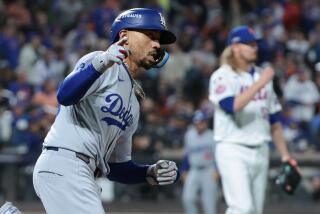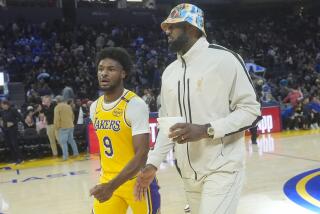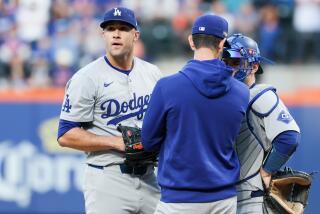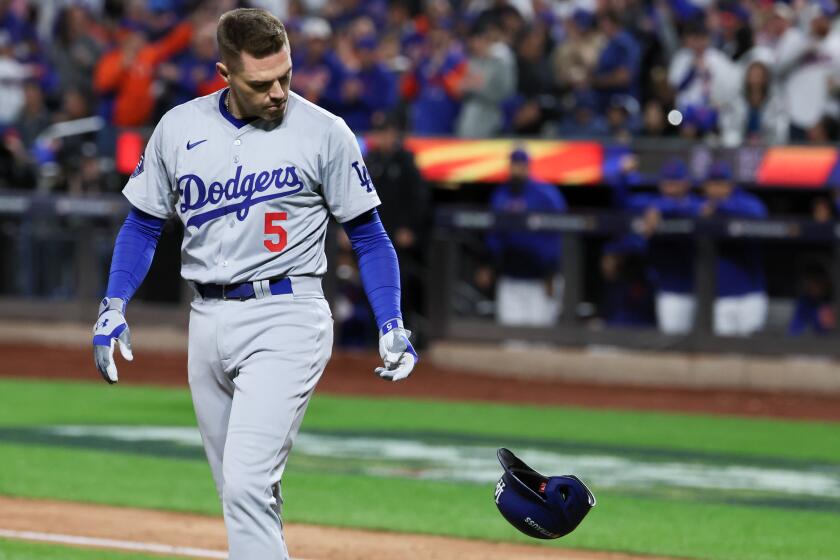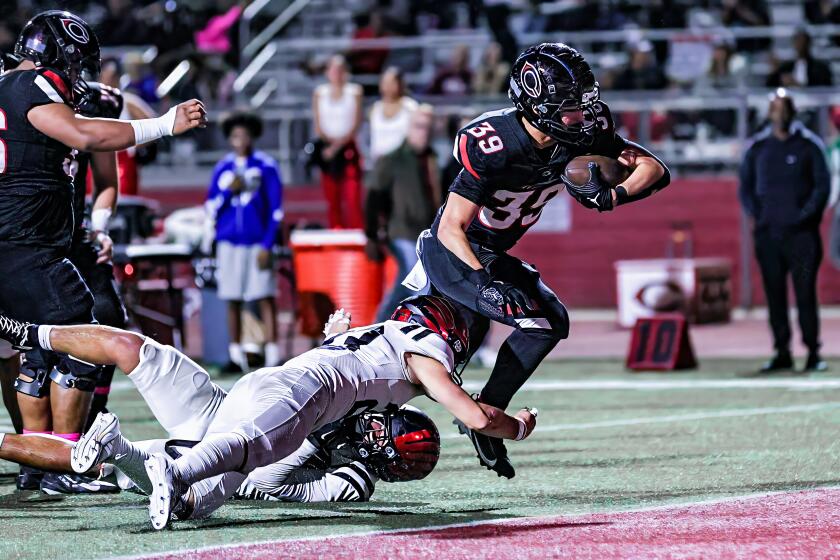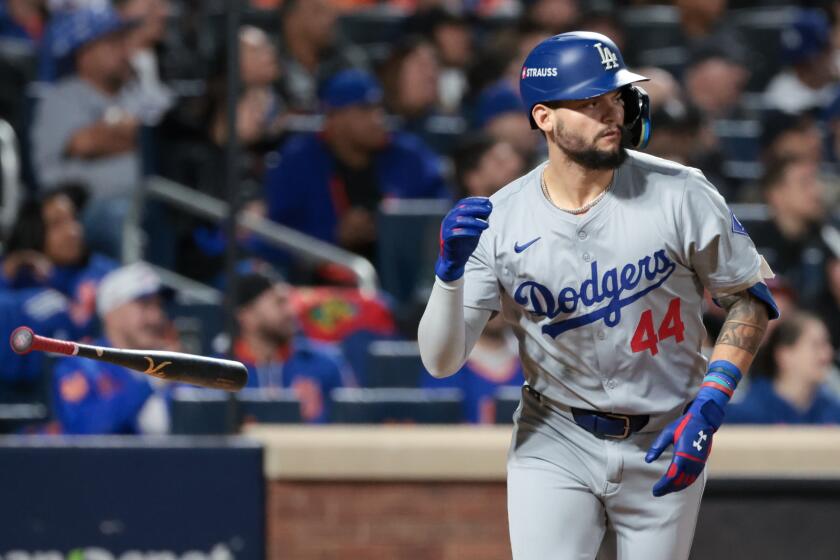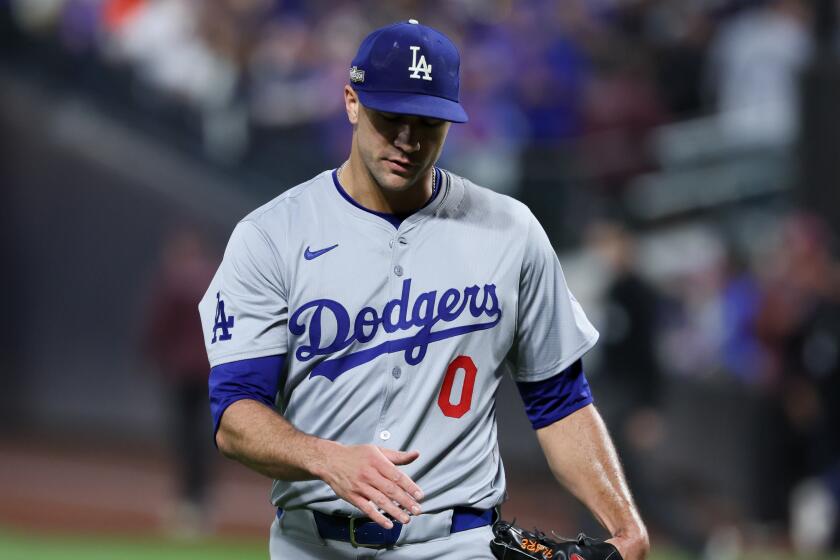Cardsharks Dealing Again : With Strike Over, Baseball Collectors Shuffle Back
Like a swimmer who nervously dips a big toe into 40-degree water, baseball-card collectors are cautiously coming back.
Although nobody rushed to embrace Barry Bonds or Bobby Bonilla when they returned to camp this week, baseball hobbyists are warming up their cold shoulders.
During the 232-day strike, baseball card sales were dormant, even dead.
“Little leaguers would walk in with their hats and gloves and they’d buy basketball cards,” said Chris Allen, owner of Squeezers Sports Cards and Collectibles in Winnetka.
Now, however, the cards are moving, but slowly.
“You’ve got die-hards that are so happy it’s back,” said Max Himmelstein, owner of Valley Baseball Card Shop in Tarzana. “They’re so resilient, you could not have baseball for eight years and the next day, they’d be back.”
Jeff Leaverton, owner of AAA Wholesale Baseball Card Co. in Thousand Oaks, also noticed enthusiasm among his customers.
“The day the strike was over, everybody came in,” Leaverton said. “Once again, people are speculating how well Frank Thomas will do this year, how Matt Williams, Jeff Bagwell and Ken Griffey Jr. will do.”
One young collector is glad the speculation ends on April 26, the start of the season.
“I’m glad baseball’s back,” said John McCrary, 14. “If your player’s Frank Thomas, you couldn’t see how he was playing because he wasn’t playing.”
But for some collectors, the strike wounds run deep.
“I’m done with baseball,” said Sean Schray, 26, who sold several Tony Gwynn and Wade Boggs rookie cards to a dealer. Schray had collected cards since he was 8.
“At the time they meant something,” he said. “Now . . . . “
The sentiment is shared by countless collectors.
Take Mark Sprague. He loved collecting so much he purchased 100 shares of stock in Topps Inc., a card-producing giant.
He sold his shares as soon as the strike began. Good judgment on his part: The shares, which reached $18 each in the early 1990s, have dropped to $5.
Sprague used to celebrate the beginning of baseball season by purchasing a case of 3,000 Topps cards, an investment upward of $300. He hasn’t purchased a single pack this season.
“If the players would have won or the owners would have won and the strike meant something, I would have bought cards,” said Sprague, 27. “Since it was meaningless, I’ve just given up.”
The end of the strike didn’t really settle anything. The National Labor Relations Board and U.S. District Court intervened, forcing owners to resume operations under the old economic system.
But an economic system for the 1996 season has not been agreed upon, leaving the door open for a strike later this season if negotiations falter.
“This thing isn’t really settled,” said Ted Taylor, Director of Hobby Relations for Fleer Corp., a baseball card producer. “When they have an agreement, then it’ll be over. But until then, it’s still hanging.”
Taylor said Fleer, which also produces hockey cards, saw a different response when the hockey strike ended with a definitive settlement.
“The very next day, I sold out of all the remaining inventory I had on two different (hockey) products,” said Taylor. “It didn’t happen in baseball that way.”
Lack of interest during the strike forced Topps, Fleer and other card companies to cut up to 60% of their baseball-card production. The card sets of major leaguers continued, but on a made-to-order basis. Nobody wanted to buy, so no hobby shops ordered.
Sports card collectors found other avenues to pursue.
Some collected football cards, boosting the doormats of the card kingdom.
Basketball cards, which closely rivaled baseball in popularity before the strike, maintained their sales success.
But baseball wasn’t completely forgotten.
Yes, today’s stars were given the boot. The cards of Bonds, the moody slugger of the San Francisco Giants, dropped 15% last month.
Even Griffey Jr., the well-liked and talented Seattle Mariner outfielder, didn’t sell during the strike. One store was stuck with 50 of his 1989 Upper Deck rookie cards, valued at $75 each.
Instead, hobbyists went after the baseball stars of yesteryear.
Sandy Koufax, Ted Williams, Mickey Mantle and Roberto Clemente all sold well. After all, they never went on strike.
“We’ve been blowing through tons of nice, quality older cards,” said store owner Leaverton. “The older card market has always been very good, but now it’s rejuvenated.”
The irony of it all: The cards that nobody wanted to buy are now a scarce and valuable commodity.
“Because of cutback in production, the stuff we produced during the strike will ultimately be the priciest stuff of the decade,” said Fleer’s Taylor
Taylor pointed to “Hot Gloves” cards randomly inserted in 1994 Flair baseball packs, owned by Fleer.
The Griffey Jr. card is worth $110 and the entire 10-card set is valued at $350.
But Taylor said not to expect replacement-player sets from any of the major card producers--it would jeopardize the companies’ relationship with major leaguers.
Whether baseball reclaims the sports-card crown is as uncertain as baseball’s status.
Hobbyists are left facing a king-sized curveball: To collect or not to collect.
Perhaps store owner Allen has the best solution.
“If I had a 10- or 11-year-old kid, I’d tell him to idolize Spider-Man,” Allen said.
More to Read
Go beyond the scoreboard
Get the latest on L.A.'s teams in the daily Sports Report newsletter.
You may occasionally receive promotional content from the Los Angeles Times.
